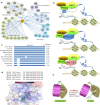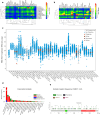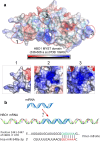Deciphering structure, function and mechanism of lysine acetyltransferase HBO1 in protein acetylation, transcription regulation, DNA replication and its oncogenic properties in cancer
- PMID: 31535175
- PMCID: PMC11104888
- DOI: 10.1007/s00018-019-03296-x
Deciphering structure, function and mechanism of lysine acetyltransferase HBO1 in protein acetylation, transcription regulation, DNA replication and its oncogenic properties in cancer
Abstract
HBO1 complexes are major acetyltransferase responsible for histone H4 acetylation in vivo, which belongs to the MYST family. As the core catalytic subunit, HBO1 consists of an N-terminal domain and a C-terminal MYST domain that are in charge of acetyl-CoA binding and acetylation reaction. HBO1 complexes are multimeric and normally consist of two native subunits MEAF6, ING4 or ING5 and two kinds of cofactors as chromatin reader: Jade-1/2/3 and BRPF1/2/3. The choices of subunits to form the HBO1 complexes provide a regulatory switch to potentiate its activity between histone H4 and H3 tails. Thus, HBO1 complexes present multiple functions in histone acetylation, gene transcription, DNA replication, protein ubiquitination, and immune regulation, etc. HBO1 is a co-activator for CDT1 to facilitate chromatin loading of MCM complexes and promotes DNA replication licensing. This process is regulated by mitotic kinases such as CDK1 and PLK1 by phosphorylating HBO1 and modulating its acetyltransferase activity, therefore, connecting histone acetylation to regulations of cell cycle and DNA replication. In addition, both gene amplification and protein overexpression of HBO1 confirmed its oncogenic role in cancers. In this paper, we review the recent advances and discuss our understanding of the multiple functions, activity regulation, and disease relationship of HBO1.
Keywords: BRD1; CDK11; Jade-1; KATs; MOF; ORC1; T cell; YAP1.
Conflict of interest statement
The authors declare no conflicts of interest.
Figures





Similar articles
-
The scaffolding protein JADE1 physically links the acetyltransferase subunit HBO1 with its histone H3-H4 substrate.J Biol Chem. 2018 Mar 23;293(12):4498-4509. doi: 10.1074/jbc.RA117.000677. Epub 2018 Jan 30. J Biol Chem. 2018. PMID: 29382722 Free PMC article.
-
Multifunctional acyltransferase HBO1: a key regulatory factor for cellular functions.Cell Mol Biol Lett. 2024 Nov 14;29(1):141. doi: 10.1186/s11658-024-00661-y. Cell Mol Biol Lett. 2024. PMID: 39543485 Free PMC article. Review.
-
Exchange of associated factors directs a switch in HBO1 acetyltransferase histone tail specificity.Genes Dev. 2013 Sep 15;27(18):2009-24. doi: 10.1101/gad.223396.113. Genes Dev. 2013. PMID: 24065767 Free PMC article.
-
HBO1 histone acetylase activity is essential for DNA replication licensing and inhibited by Geminin.Mol Cell. 2010 Jan 15;37(1):57-66. doi: 10.1016/j.molcel.2009.12.012. Mol Cell. 2010. PMID: 20129055 Free PMC article.
-
HBO1, a MYSTerious KAT and its links to cancer.Biochim Biophys Acta Gene Regul Mech. 2024 Sep;1867(3):195045. doi: 10.1016/j.bbagrm.2024.195045. Epub 2024 Jun 6. Biochim Biophys Acta Gene Regul Mech. 2024. PMID: 38851533 Review.
Cited by
-
Effects of Long Non-Coding RNAs Induced by the Gut Microbiome on Regulating the Development of Colorectal Cancer.Cancers (Basel). 2022 Nov 25;14(23):5813. doi: 10.3390/cancers14235813. Cancers (Basel). 2022. PMID: 36497293 Free PMC article. Review.
-
A first-in-class HBO1 inhibitor WM-3835 inhibits castration-resistant prostate cancer cell growth in vitro and in vivo.Cell Death Dis. 2023 Jan 28;14(1):67. doi: 10.1038/s41419-023-05606-5. Cell Death Dis. 2023. PMID: 36709328 Free PMC article.
-
HBO1 is a versatile histone acyltransferase critical for promoter histone acylations.Nucleic Acids Res. 2021 Aug 20;49(14):8037-8059. doi: 10.1093/nar/gkab607. Nucleic Acids Res. 2021. PMID: 34259319 Free PMC article.
-
HBO1 determines epithelial-mesenchymal transition and promotes immunotherapy resistance in ovarian cancer cells.Cell Oncol (Dordr). 2025 Aug;48(4):943-959. doi: 10.1007/s13402-025-01055-8. Epub 2025 Apr 14. Cell Oncol (Dordr). 2025. PMID: 40227530 Free PMC article.
-
Protein acetylation: a novel modus of obesity regulation.J Mol Med (Berl). 2021 Sep;99(9):1221-1235. doi: 10.1007/s00109-021-02082-2. Epub 2021 Jun 1. J Mol Med (Berl). 2021. PMID: 34061242 Review.
References
-
- Feng Y, Vlassis A, Roques C, Lalonde ME, Gonzalez-Aguilera C, Lambert JP, Lee SB, Zhao X, Alabert C, Johansen JV, Paquet E, Yang XJ, Gingras AC, Cote J, Groth A. BRPF3–HBO1 regulates replication origin activation and histone H3K14 acetylation. EMBO J. 2016;35(2):176–192. doi: 10.15252/embj.201591293. - DOI - PMC - PubMed
-
- Mishima Y, Miyagi S, Saraya A, Negishi M, Endoh M, Endo TA, Toyoda T, Shinga J, Katsumoto T, Chiba T, Yamaguchi N, Kitabayashi I, Koseki H, Iwama A. The Hbo1–Brd1/Brpf2 complex is responsible for global acetylation of H3K14 and required for fetal liver erythropoiesis. Blood. 2011;118(9):2443–2453. doi: 10.1182/blood-2011-01-331892. - DOI - PubMed
Publication types
MeSH terms
Substances
Grants and funding
LinkOut - more resources
Full Text Sources
Medical
Research Materials
Miscellaneous

